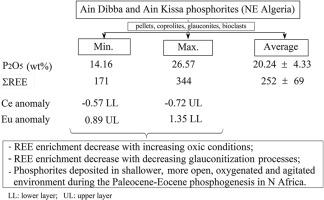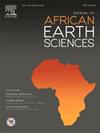泰贝萨(阿尔及利亚东北部)的 Ain Dibba 和 Ain Kissa 磷酸盐岩:北非古新世-始新世磷酸盐形成过程中 REE 贫化与浅层、开放沉积环境的关系
IF 2.2
4区 地球科学
Q2 GEOSCIENCES, MULTIDISCIPLINARY
引用次数: 0
摘要
Ain Dibba 和 Ain Kissa 磷矿位于阿尔及利亚东北部泰贝萨镇以北,属于上白垩世-古新世-始新世非洲-阿拉伯磷矿带,该磷矿带从摩洛哥延伸到中东。这两个磷酸盐矿床沉积于晚古新世(塔尼蒂)时期的卡塞林古岛北部盆地,在 20 世纪初被部分开采。虽然它们在经济上还不是很重要,但目前的岩石学和地球化学研究对了解它们的关键痕量和 REE 含量以及了解它们的古沉积环境有很大帮助。岩石学和 X 射线衍射数据显示,这些磷酸盐岩主要由球粒、共生岩、生物碎屑岩以及稀有的青云石、石膏、石英颗粒和沸石组成。这些成分由石灰质、硅质或极少数粘土质基质胶结而成。颗粒和桡长石主要由隐晶碳酸盐氟磷灰石(CFA)组成。对这些磷酸盐岩进行的 XRF 和 ICP-MS 化学分析表明,无论是 P2O5 还是 REE 含量,它们都不如 Kef Essenoun 和 Bled El Hadba 南部盆地的磷酸盐岩丰富。P2O5 含量从 14.16 到 26.57 wt%(平均 = 20.24 ± 4.33 wt%,n = 15)不等,只有一个样本的 P2O5 含量为 31.89 wt%,而 ΣREE 含量从 171 到 344 ppm(平均 = 252 ± 69 ppm,n = 9)不等,因此被认为是中度富含 REE 的磷酸盐岩。Ce异常值从磷酸盐岩下层向上层递减(从-0.57下降到-0.72),表明磷酸盐岩从相对亚缺氧状态上升到较缺氧状态。艾因迪巴磷酸盐岩的 Eu 异常值从 0.89 到 1.35 不等,艾因基萨磷酸盐岩的 Eu 异常值从 0.93 到 1.35 不等。Ce/Ce∗最高、Eu/Eu∗最低的异常记录在下层,通常富含 REE 和白榴石,而 Ce/Ce∗最低、Eu/Eu∗最高的异常反映了更多的氧化条件,是不含白榴石和 REE 贫乏的上层的特征。氧化还原敏感性(铬、镍、钒、铀)微量元素数据也记录了从相对亚氧化到氧化条件(从下层到上层)的逐步时间过渡。这意味着,在早期成岩过程中,沉积环境变得略微酸化,这使得REE和一些微量元素(如铬、钒、镍、铀)主要通过磷灰石和青金石矿物的置换和吸附机制从孔隙水中大量吸收。这种情况在艾因迪巴和艾因基萨矿床的磷酸盐岩下层尤为明显。在更大范围内,与卡塞林古岛南部盆地(Kef Essenoun 和 Bled El Hadba)和东部盆地(突尼斯)的磷酸盐岩相比,Ain Dibba 和 Ain Kissa 磷酸盐岩显示出较低的 REE 含量、较低的 Ce 和 Eu 异常,以及较低的氧化还原敏感微量元素含量。这些地球化学特征表明,在北非和中东地区的古新世-始新世磷酸盐形成过程中,北部盆地的磷酸盐岩是通过上升流沉积在更为开阔、较浅、含氧和搅拌环境中的。本文章由计算机程序翻译,如有差异,请以英文原文为准。

The Ain Dibba and Ain Kissa phosphorites, Tebessa (NE Algeria): REE depletion versus shallow, open depositional environment during the Paleocene-Eocene phosphogenesis in North Africa
The Ain Dibba and Ain Kissa phosphorites, located north of Tebessa town, NE Algeria, belong to the Upper Cretaceous-Paleocene-Eocene Afro-Arabian phosphatic province that extends from Morrocco to the Middle East. These two phosphorite showings, which were partly exploited at the beginning of the 20th century, were deposited during the Late Paleocene (Thanetian) times on the northern basin of the Kasserine Paleo-Island. Although they are not yet economically very important, the present petrological and geochemical study contribute highly to the knowledge of their critical trace and REE contents as well as the understanding of their paleo-depositional environment. Petrographic and XRD data show that these phosphorites are mainly composed of pellets, coprolites, bioclasts and rare glauconite, gypsum, quartz grains and zeolites. These constituents are cemented by calcareous, siliceous or rarely clayey matrix. The pellets and coprolites are composed mainly of cryptocrystalline carbonate fluor-apatite (CFA). The XRF and ICP-MS chemical analyses of these phosphorites, show they are not as rich as those from Kef Essenoun and Bled El Hadba southern basin, neither in P2O5 nor in REE contents. P2O5 concentrations range from 14.16 to 26.57 wt% (average = 20.24 ± 4.33 wt%, n = 15), with only one sample having 31.89 wt% P2O5, whereas ΣREE contents range from 171 to 344 ppm (average = 252 ± 69 ppm, n = 9) and, therefore, considered as moderately REE-enriched phosphorites. Ce anomaly values display a decrease from the lower to the upper phosphorite sub-layers (from −0.57 down to −0.72), suggesting an increase from relatively sub-oxic to more oxic conditions. The Eu anomalies range from 0.89 to 1.35 for Ain Dibba and from 0.93 to 1.35 for Ain Kissa phosphorites. The highest Ce/Ce∗ and lowest Eu/Eu∗ anomalies are recorded in the lower layers, often enriched in both REE and glauconite contents, whereas the lowest Ce/Ce∗ and highest Eu/Eu∗ anomalies, reflecting more oxic conditions, are characteristics of the glauconite-free and REE-poor upper layers. The gradual timewise transition from relatively sub-oxic to oxic conditions (from the lower to the upper layers) is also recorded in the redox-sensitive (Cr, Ni, V, U) trace element data. This implies that during early diagenesis, the sedimentary environment became slightly reduced, which enabled intensive uptake of both REE and some trace element (e.g., Cr, V, Ni, U) mainly from pore-water through substitution and adsorption mechanisms onto apatite and glauconite minerals. This is noticed especially in the lower phosphorite layers of both Ain Dibba and Ain Kissa deposits. In a larger scale, the Ain Dibba and Ain Kissa phosphorites show lower REE contents, lower Ce and Eu anomalies, and lower redox-sensitive trace element contents than those of the southern (Kef Essenoun and Bled El Hadba) and eastern (Tunisian) basins of the Kasserine paleo-Island. These geochemical features indicate that phosphorites from the northern basin were deposited, through upwelling current, in a more open, shallower, oxygenated and agitated environment during the Paleocene-Eocene phosphogenesis in North Africa and Middle East.
求助全文
通过发布文献求助,成功后即可免费获取论文全文。
去求助
来源期刊

Journal of African Earth Sciences
地学-地球科学综合
CiteScore
4.70
自引率
4.30%
发文量
240
审稿时长
12 months
期刊介绍:
The Journal of African Earth Sciences sees itself as the prime geological journal for all aspects of the Earth Sciences about the African plate. Papers dealing with peripheral areas are welcome if they demonstrate a tight link with Africa.
The Journal publishes high quality, peer-reviewed scientific papers. It is devoted primarily to research papers but short communications relating to new developments of broad interest, reviews and book reviews will also be considered. Papers must have international appeal and should present work of more regional than local significance and dealing with well identified and justified scientific questions. Specialised technical papers, analytical or exploration reports must be avoided. Papers on applied geology should preferably be linked to such core disciplines and must be addressed to a more general geoscientific audience.
 求助内容:
求助内容: 应助结果提醒方式:
应助结果提醒方式:


